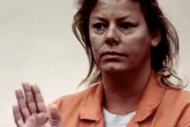Create a free profile to get unlimited access to exclusive videos, breaking news, sweepstakes, and more!
8 Of The Most Shocking Moments From The Aileen Wuornos Murder Trial
Dubbed the “The Damsel of Death,” Wuornos became one of America’s most notorious female serial killers.
On January 9, 1991, sex worker and serial killer Aileen Wuornos was arrested at The Last Resort Bar in Port Orange, Florida. A week later, 34-year-old Wuornos confessed to killing seven men after they picked her up hitchhiking on roadways across The Sunshine State.
Dubbed the “The Damsel of Death,” Wuornos became one of America’s most notorious female serial killers, and her trial for the murder of 52-year-old Richard Mallory was steeped in controversy.
Here are some of the most shocking moments from the Aileen Wuornos murder trial:
1. Wuornos’ ex-girlfriend pushed her to confess.
Shortly after Wuornos’ arrest, police located her ex-girlfriend, Tyria Moore, in Scranton, Pennsylvania. Moore, 28, denied any involvement in the murders and agreed to help police in order to clear her own name.
According to The Washington Post, Moore headed back to Florida and was put up in a Daytona Beach motel room for four days by police. They reportedly kept her supplied with “plenty of Budweiser and hamburgers” as they tape-recorded 10 telephone calls between Moore and Wuornos while she was in jail.

During one of their conversations, Moore told Wuornos she was afraid police were going to arrest her for the murders. According to the Orlando Sentinel, Moore also talked about committing suicide.
Wuornos responded, “You’re innocent. I’m not gonna let you go to jail. Listen, if I have to confess, I will.”
She also told Moore, “I am the one who did everything. I cannot let you get in trouble for something you did not do.”
2. Wuornos confessed to seven murders, but she said it was in self-defense.
On January 16, 1991, Wuornos confessed to killing the seven men after they picked her up hitchhiking.
She told police, “I just wish I never woulda done what I did. [...] I still have to say to myself, I still say that it was in self-defense. Because most of ‘em either were gonna start to beat me or were gonna screw me in the ass. [...] They’d get rough with me, so I’d fight ‘em and I’d get away from ‘em. [...] As I’d get away from them [...] I’d grab my gun and just start shootin’.”
Wuornos said she was confessing because she didn’t want Moore to get “messed up for somethin’ I did. [...] I know I’m gonna miss her for the rest of my life.”
Wuornos also gave directions for a dive team to recover her weapon, the .22 caliber pistol. She was then charged in connection with the murder of Richard Mallory.
3. A judge allowed in evidence from all six murders.
Though Wuornos’s first trial was only for the murder of her first victim Mallory, a judge ruled to allow in evidence from the six other murders. The prosecution was able to present this evidence due to Florida’s law known as Williams Rule, which allows “evidence related to collateral crimes to be admitted if it helps to show motive, intent, knowledge, modus operandi, or lack of mistake.”
4. Wuornos’ ex-girlfriend testified against her.
Along with evidence from the other murders, the prosecution also had a star witness: Tyria Moore. According to the Orlando Sentinel, Wuornos “clutched a handkerchief as Moore's name was called,” and Moore avoided eye contact with Wuornos during her testimony.
Moore testified that on the day of Mallory was shot, Wuornos told her she had killed a man. According to Moore, she said she didn’t want to believe it and told Wuornos to stop talking about it. Moore also said Wuornos didn’t appear injured or upset the day she told her about the killing.
Moore was never charged or implicated in the murders.
5. Wuornos was found guilty.
After two hours of deliberation, the jury found Wuornos guilty of first-degree murder.
When the verdict was announced, Wuornos was visibly upset and shouted, “I was raped. I hope you get raped, Scumbags of America.”
In the penalty phase of her trial, the same jurors were asked to recommend a sentence for Wuornos. The prosecution was seeking the death penalty, and the defense was seeking life without parole.
6. Wuornos’ relative testified against her.
Wuornos’ mental health was brought up during the penalty phase. The defense asserted Wuornos suffered from a personality disorder.
One defense psychologist said, “Ms. Wuornos is probably one of the most primitive people I’ve seen outside an institution.”
Her lawyers also contended her grandfather was an alcoholic who abused her physically and emotionally.
But Wuornos’ claims were challenged when Barry Wuornos, her grandfather’s son, testified that he had never seen his father beat or abuse Wuornos.
He said, “We were a pretty straight and normal family — very little trouble in the family.”
7. Movie deals were being made during the trial.
In the middle of the trial, it was discovered several investigators hired a lawyer to represent them for film rights for their story of capturing Wuornos. It was also speculated that Moore was involved in the movie deal, but those claims were never substantiated.
The state attorney’s opened an investigation but found no wrongdoing.
8. Wuornos was sentenced to death.
On January 31, 1992, Wuornos was sentenced to death.
At sentencing the judge said, “By warrant of the governor of the state of Florida, you, Aileen Carol Wuornos, be electrocuted until you are dead.”































